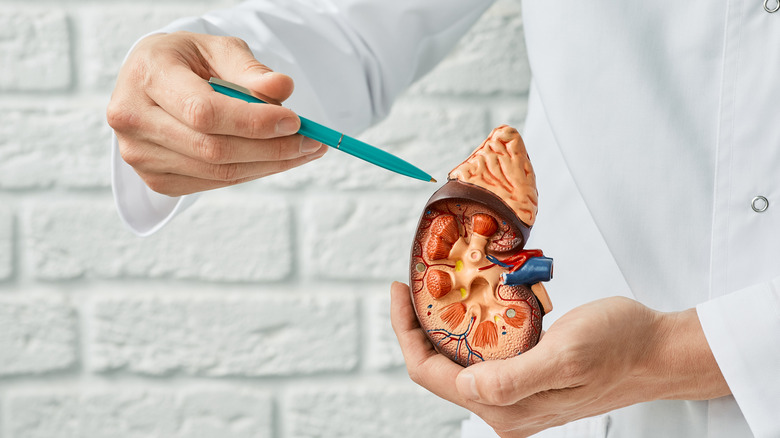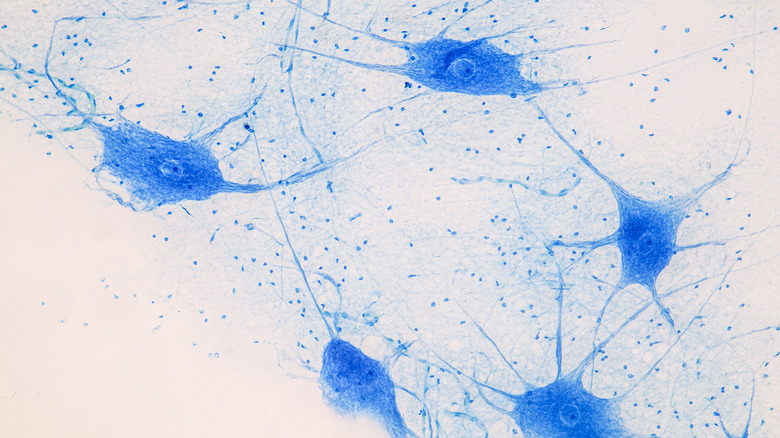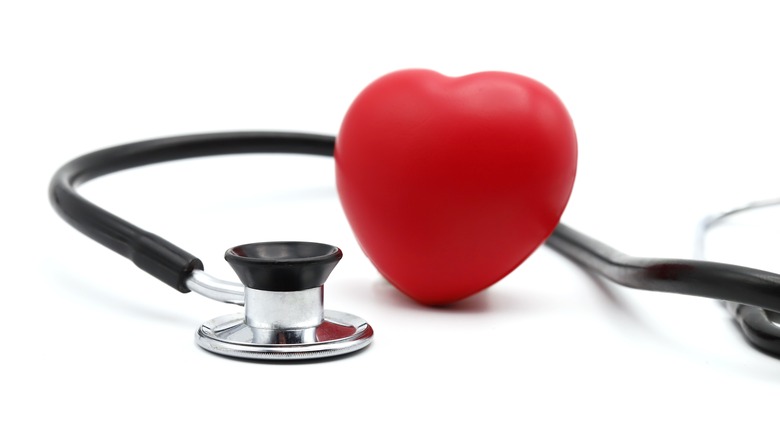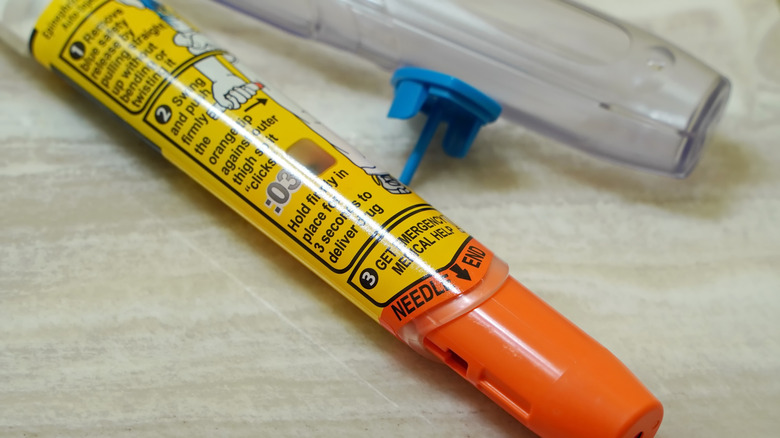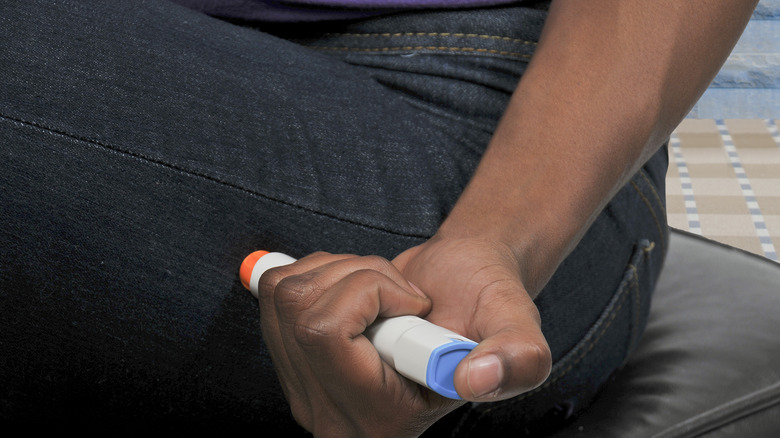The Real Effects Adrenaline Has On Your Body
Adrenaline is both a hormone and neurotransmitter. According to the Cleveland Clinic, it's also called epinephrine, and it plays a number of roles in the body. The hormone is made in the two adrenal glands in your body, one on top of each kidney. These small glands secrete adrenaline into your blood.
Acting as a neurotransmitter, adrenaline sends chemical messages throughout your central nervous system. In the brain, adrenaline helps nerve cells communicate with other nerve cells. They also communicate with muscle cells and gland cells. Adrenaline belongs to a group of hormones called catecholamines. Also included in this group are norepinephrine and dopamine. They're considered catecholamines because of their chemical structure.
Primarily, adrenaline acts as a hormone in the body. It's part of the "fight-or-flight" response, which is your body's way of reacting to an emergency situation. It's used as medication in case you have too little, but can also be dangerous if you have too much. Here are some of the real effects of adrenaline on your body.
How adrenaline is made
Your adrenal glands, which sit on top of your kidneys, are shaped like two small triangles, says Johns Hopkins Medicine. These glands have two parts, the cortex and medulla. Each part produces different hormones. The medulla is the part that produces adrenaline (per the Endocrine Society).
There are more hormones in your adrenal glands than just adrenaline, though. Cortisol and aldosterone are just two of the other kinds of hormones that play important roles in the body. If your adrenal glands stop working, there can be a cascade of effects throughout the body (via the Cleveland Clinic). Additionally, if your adrenal glands don't produce enough quantities of certain hormones, you can develop something called adrenal insufficiency, also known as Addison's disease.
Some of the neurons in your body can also produce adrenaline, according to the Endocrine Society. During a stressful situation, adrenaline is excreted into your bloodstream to circulate through the body. It travels to organs and creates different responses in each of them.
Adrenaline triggers the fight-or-flight response
Have you ever been in a perilous situation (for example, walking through the woods and encountering a bear or some other dangerous animal)? You probably felt the fight-or-flight response to danger. The surge of energy in your body quickly prepares you to either fight or escape. Adrenaline triggers this response, according to the Endocrine Society.
There are a number of changes that occur in the body as part of the fight-or-flight response. As adrenaline surges through your bloodstream, your airways begin to open wider. This allows more air into your lungs and increases the amount of oxygen you can consume. Your blood gets directed to areas of your body that include important muscle groups, such as your legs and arms. It also redirects blood towards your heart and brain. Your perception of pain decreases when adrenaline is released, so you might not notice things that hurt previously. Another benefit of the fight-or-flight response is increased strength, athletic performance, and focus.
Adrenaline is part of the hypothalamic-pituitary-adrenal axis
The stress response, also known as the fight-or-flight response, is controlled by a network in your body called the hypothalamic-pituitary-adrenal (HPA) axis. The University of New Hampshire's Psychology and Counseling Services explains that when you encounter something that you regard as stressful or threatening, the part of your brain called the hypothalamus releases what's called corticotropin-releasing-hormone (CRH).
CRH then prompts the pituitary gland to release a different hormone called adrenocorticotropic hormone (ACTH) into the bloodstream. ACTH floats through your blood until it arrives at the adrenal glands. Once it's there, it tells the adrenal glands to secrete certain hormones, including adrenaline.
The adrenal glands also release cortisol, which is commonly associated with stress. If the levels of cortisol in your blood are too high, the brain shuts down the HPA axis. This system allows your body to control how much adrenaline is floating through your body. A body that's subjected to stress less frequently tends to have a healthier and more responsive HPA axis.
Differences between adrenaline and noradrenaline
There are two hormones with similar names in your body, which produce similar effects: adrenaline and noradrenaline. There are some key differences between the two, which the Cleveland Clinic explains.
Both are hormones and neurotransmitters, although noradrenaline is more of a neurotransmitter and adrenaline is mainly a hormone. Adrenaline is mostly made in the adrenal glands, while noradrenaline is mostly made in the nerves. Additionally. noradrenaline is constantly moving through your body; meanwhile, adrenaline only gets released when you need it. Another key difference is that adrenaline is actually made from noradrenaline, whereas noradrenaline is made from dopamine.
Adrenaline affects most of the tissues in the body, and can be used as a medication in people with severe asthma and low blood pressure. On the other hand, noradrenaline mainly controls the blood pressure in your blood vessels or increases it. Noradrenaline is used in an emergency if you have low blood pressure.
Cardiovascular effects of adrenaline
To get your body moving and boost your performance in case you need to react to a stressful situation, adrenaline primes your cardiovascular system for activity. In addition to widening your airways to let more oxygen in, adrenaline increases your heart rate and the force of each heartbeat (per the Colorado State University). This increase is the product of the interaction between adrenaline and the body's beta receptors.
According to StatPearls, beta receptors are in areas of the body like the heart, kidney, and fat cells. These receptors are sensitive to hormones like adrenaline. When these beta receptors are activated in the heart, it results in a more powerful firing of the heart muscle. This, in turn, increases the amount of blood your heart pumps out and the number of times it beats per minute. Adrenaline also causes your blood vessels to narrow, which can result in high blood pressure.
Adrenaline increases blood glucose levels
As part of the fight-or-flight response, adrenaline provides your body with a fuel source. That comes in the form of glucose, which adrenaline is able to increase using a few different strategies (as described in a paper published by StatPearls).
One of the ways adrenaline increases blood sugar levels is by stimulating glycogenolysis in the liver. According to an article from StatPearls, glycogenolysis takes glycogen, which is a form of sugar that your body uses for storage, into glucose (which your body uses for fuel).
Adrenaline tells the pancreas to produce less insulin (via the Society for Endocrinology), and also increases glucagon secretion (per StatPearls). Glucagon helps stimulate glycogenolysis, which provides the body with an energy boost (per Encyclopedia Britannica). It also tells the liver to convert its stored glucose into a usable form that can be released into the blood, according to the Endocrine Society. Glucagon also stimulates the body to make glucose from other things, such as amino acids.
Adrenaline boosts exercise performance
The family of hormones called catecholamines all play a role in boosting exercise performance. However, adrenaline is probably the most important, according to the National Strength and Conditioning Association (NSCA).
The response you get from an intense resistance training session is similar to the fight-or-flight response. The NSCA cites research that men who had higher levels of these catecholamines as they exercised were able to keep up a higher amount of force production for longer.
Not only can adrenaline boost workouts, but workouts can also boost adrenaline. Athletes who practiced heavy weight training were able to increase the amount of adrenaline they could excrete during maximum effort exercise. They also mention that the release of adrenaline affects other hormones, such as testosterone and growth hormone. While the boost you get from adrenaline is helpful in the short term, it wears off over time. However, the NSCA warns that continued, long-term elevation of the catecholamines can prevent you from recovering from workouts.
Does exercise raise or lower adrenaline levels?
While exercise can cause a spike in adrenaline, it can also lower levels of the hormone in your body. It might seem confusing, but adrenaline spikes in the beginning of your workout, explains the American Psychological Association (APA). After your workout, hormones like cortisol and adrenaline drop, which makes exercise a form of stress relief.
The APA suggests that since the response to exercise is so similar to stress in your body, it could be a form of practice. In other words, the more you exercise, the more you're used to dealing with stress, making it less of a huge deal for the body to handle.
Another boost from exercise is the release of endorphins, which make you feel good and reduce the sensation of pain, according to Harvard Health. These chemicals are thought to cause something known as the "runner's high," which is a feeling of euphoria that many runners have while or after doing distance runs.
Adrenaline may help form memories
The fight-or-flight response is a natural reaction to a fearful event. You might find that you can recall vivid memories of times you were scared, or you become more cautious after something scary happens to you. Fear memory is the most-studied form of memory, according to a paper published in Physiological Reviews. The authors explain that fear is formed in parts of the brain called the hippocampus and amygdala. The effects of fear on memory can be studied using techniques called fear conditioning.
A study published in Frontiers in Molecular Neuroscience studied the effect of adrenaline on memory formation in mice. The researchers used fear conditioning techniques to see how adrenaline release affected their memory. Their findings were that higher amounts of adrenaline were associated with a better memory from fearful events. The authors conclude that adrenaline is important for the formation of memory from fearful events, but that norepinephrine isn't.
A rare tumor can lead to an excess of adrenaline
Of course, too much adrenaline can be harmful for the body. A possible cause for excess amounts of adrenaline or noradrenaline being secreted from the adrenal gland is a pheochromocytoma, according to Johns Hopkins Medicine.
A pheochromocytoma is an uncommon type of tumor that forms in the adrenal gland. Experts aren't sure about what really causes it, but genetics may have something to do with it (via Johns Hopkins Medicine). The people most at risk of developing this are men and women from 30 to 59 years of age.
The symptoms of a pheochromocytoma are a fast pulse and feeling like your heart is racing. You might have mild symptoms like a headache and nausea or clammy skin. The most common symptom is high blood pressure. A pheochromocytoma can be diagnosed with imaging tests, blood tests, and a radioisotope scan. It can be treated with surgery or medicine. Most of the tumors are benign, thankfully, meaning they're not cancerous and most likely won't come back after they're removed.
Too much adrenaline can damage the body
The fight-or-flight response is incredibly helpful for avoiding danger or priming your body to exercise. It's meant to get your body ready for activity, which means it's good in short bursts. If you have a low-level activation of the fight-or-flight response for a long time, it can be damaging to your body, according to Harvard Health Publishing.
Known as chronic stress, constant activation of the HPA axis is unhealthy. It results in frequent releases of adrenaline, which can damage blood vessels. This raises your risk for heart attack or stroke. You'll also have too much cortisol in your body if you have chronic stress, which contributes to weight gain in the long term.
Relaxation practices such as yoga and tai chi can be helpful if you suffer from chronic stress. You can also use exercise to help combat stress. Enjoying close relationships with friends and family can also relieve chronic stress.
What happens when you don't have enough adrenaline?
There are problems associated with high levels of adrenaline in the body, but having too little can also be dangerous.
Healthdirect Australia explains that it's rare — but not impossible — for someone to have too little adrenaline, and that this means they may find stressful times even more challenging to deal with. The Cleveland Clinic lists some of the symptoms associated with low adrenaline levels. You might feel anxiety and depression, or experience headaches. Sleeping problems and low blood sugar can be caused by low adrenaline levels. You can also have fluctuations in blood pressure.
If you suspect that you have low adrenaline levels, your doctor can do some tests to find out. According to MedlinePlus, catecholamine tests will gauge your levels of the hormones made by your adrenal glands (such as adrenaline, dopamine, and norepinephrine). A catecholamine test will require you to collect all of your urine within a period of 24 hours. Sometimes, a blood test may be conducted as well.
Adrenaline can be used as emergency medicine in certain situations
Typically reserved for emergency situations, adrenaline can be used for medical purposes. It comes in the form of an injection, according to MedlinePlus, and is used to treat a few life-threatening problems.
You can use an adrenaline shot for serious allergic reactions, such as a bee sting or a food allergy. It works well for an allergic reaction because adrenaline causes the muscles in the airways to relax, which makes it easier to breathe. It also tightens your blood vessels to increase blood flow back to the heart.
According to a study published in the New England Journal of Medicine, adrenaline shots can also be used for heart attacks. However, according to the authors of the study, it's not very effective at saving people who are having a heart attack. The authors also mention that people who survived the heart attack because of an adrenaline shot were almost twice as likely to have brain damage as individuals who didn't have the shot.
Side effects of injected adrenaline
Adrenaline medication can be life-saving in some scenarios. However, there are still side effects that you should be aware of.
According to MedlinePlus, you might have skin swelling or redness at the site of the injection. You may also experience some difficulty breathing after you have an adrenaline injection. Your heartbeat might feel like it's fast or pounding. In addition, dizziness, nausea, sweating, and vomiting are all possible side effects.
Just like any other medication, it's important to follow the instructions from your doctor or on the label. It's possible to overdose on adrenaline if it's taken improperly. Symptoms of an overdose include sudden weakness or numbness on one side of your body, impaired speech, and an irregular heart rate. You may also feel confused or experience shortness of breath. This medication is only for use with a prescription, so don't let anyone else take your adrenaline injection if you have one.


